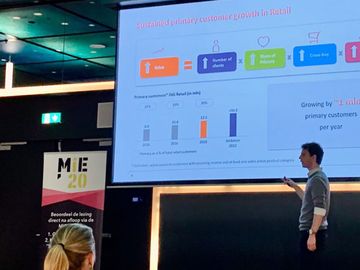
Tired of unnecessary discussions about online sales optimization? Here’s how to prevent them with two KPIs
Recently, we hosted a webinar about optimizing online CX with Bas Jansen, Digital Customer Experience Lead NL at Google. During the webinar, one very enthusiastic participant raised the question:
“How can I deal with all the unnecessary discussions and frustrations inside my company about increasing online sales?”
It is a very relevant topic, which we’ve definitely seen many times before.
In this article, we want to provide an answer, not just for that participant, but for all of you. In fact, our answer is interconnected with our core vision at WUA, which we have continued to fine-tune over the past 13 years. It’s all about consistently having the right discussions on the right level. And what the consequences are if you don’t do that. We firmly believe that you can only become the best on the web when you fully align your organization with your customer’s perspective.
Your customer’s perspective has to set the direction for your organization
You’re not reaching your targets. Conversion is down. Your competitors are gaining on you. The margins are shrinking. You’re losing market share. The people you really need right now have either given up on the discussion or already jumped ship. Those who do stay with the company feel completely drained of their energy and lack engagement… sound familiar?
At many organizations, we’ve seen that the attempt to structurally improve online sales is a major problem. It’s one of the most important questions facing any organization today: “What do we need to prioritize right now so that we can achieve consistently higher online sales?” There are always priorities that involve a little work but a lot of impact, or a lot of work but little impact.
And as a result, there is a lot of discussion and difference of opinion within the organization. Here are some of the topics and arguments that we often see during these discussions:
- IT is (too) slow and/or just isn’t getting it.
- Our product isn’t good enough and/or it just isn’t built for online sales.
- Our competitors have bigger budgets or better people, which is why they are outperforming us.
- We have to do an A/B test for any improvement we want to make.
- The price we’re asking is too high. If we lower our price, we would sell more.
- Our company’s executives do not understand online sales. That’s why they don’t give us enough budget and support.
- We had to quit using Google Ads to save money… (seriously, we’ve seen it happen!)
…
At first glance, these seem like valid arguments. And that makes these internal discussions even trickier. But a lot of times, these topics are not actually the real problem. At its core, the problem is something much deeper.
The real problem: The online sales funnel belongs to everyone
The real problem is that the online sales funnel doesn’t just belong to the digital department or the CRO team. Marketing, IT, sales, the Board… they all have an influence on it. The online sales funnel belongs to everyone, and each department has its own KPIs. Those KPIs are important; they’re very useful to us all, and they give us something to work towards each day.
But… is the sum total of a bunch of different KPIs actually that important to the organization? Wouldn’t it make more sense to have one or two KPIs that everyone within the organization shares? We think so. And Google does too.
After all, as an organization, you’ve got a lot of collective knowledge. With Google Analytics and other tools, you know exactly where your visitors are coming from, where you lose them and how many of them decide to convert in the end. What you don’t know is how the online experience on your website stacks up against your competitors. Or how it compares with the benchmark, which is all in the consumer’s thoughts and feelings. Remember, that same consumer shops on Amazon and knows how easy that is… They just ordered their washing machine on Coolblue, and today, they picked up a package at Albert Heijn that they’d ordered that same morning on bol.com.
All those experiences and expectations add up to the benchmark that the consumer carries in their mind every time they wind up on your company’s website. And that makes it an absolute necessity to monitor the online customer experience, both in absolute and relative terms!
Working with shared KPIs
Monitoring and optimizing the online experience helps you to achieve consistently higher sales… but only if you’re faster and better at it than your competitors. We argue that any organization that wants to optimize its sales needs to follow two shared KPIs. These need to be monitored for each separate customer journey (like buying a pair of headphones or a new auto insurance policy). That’s because the customer journey and the competition are different for each product or service. These two KPIs should preferably be put in place by the top level of your company and then made into a focus and target for the entire organization. The two essential KPIs are:
Digital Sales Score
What’s my position compared with that of the competition when someone is searching for my product/service? How often do they find me? What percentage ultimately chooses my product, and how much is my market share? What is my potential? Is there a winner-takes-all situation in my market?
Digital Customer Experience (CX) Score
If someone is searching for my product or service, what’s my position in terms of the experience on my site or app, compared with my competitors or the benchmark? How do we score on brand-related aspects? Our product range? And the look & feel? What can I learn from top-in-class performers, both inside and outside my market? How can I speed things up?
Whenever you really start using these two KPIs or targets as a shared goal for becoming the best on the web, then there’s a good chance that your online sales will start soaring—consistently, as well as more quickly than your competitors.
That’s because you’re incorporating your customer and the benchmark into your priorities. Along with everyone else involved in the online sales funnel (including external agencies). Preferably, you’ll consistently measure these KPIs once every quarter or half-year, depending on your market and the speed with which you start to see an improvement. In the meantime, you’ll perform qualitative usability studies on smaller portions of your site or app to fully tap into the optimization process.
The customer is always right—and they won’t let you forget that
If you’re just getting started using these KPIs, it might “hurt” a little at first. Remember that the customer is always right—and they won’t let you forget that. But before long, you’ll see that those discussions in your teams are becoming a lot easier, faster and more constructive.
Why? The shared KPIs give your teams something they can all agree on when it comes to setting priorities and having the biggest impact. By consistently measuring, you’ll also see right away whether the changes have worked or if they need to be fine-tuned. Consistent measurement is also a perfect match for an agile way of working. You all set deadlines together. This creates a sense of urgency.
And best of all: it brings positive energy and focus to the team. It literally creates a sense of satisfaction. After all, now, you’re working every day for the customer, because you’re listening to what they say. You’ll see results that really have an impact. And the ultimate result is: higher sales, stronger margins, bigger market shares and more budget to grow even faster. That means online sales optimization speeds up the current. The right people stay and they’re full of energy and motivation to get things done. It’s a win-win all around.
Do you want to start measuring the strategic aspect (how can you effectively integrate the two KPIs in your organization) and the practical side (how do I measure and visualize them)? Keep an eye out for part 2 of this article, coming soon.


